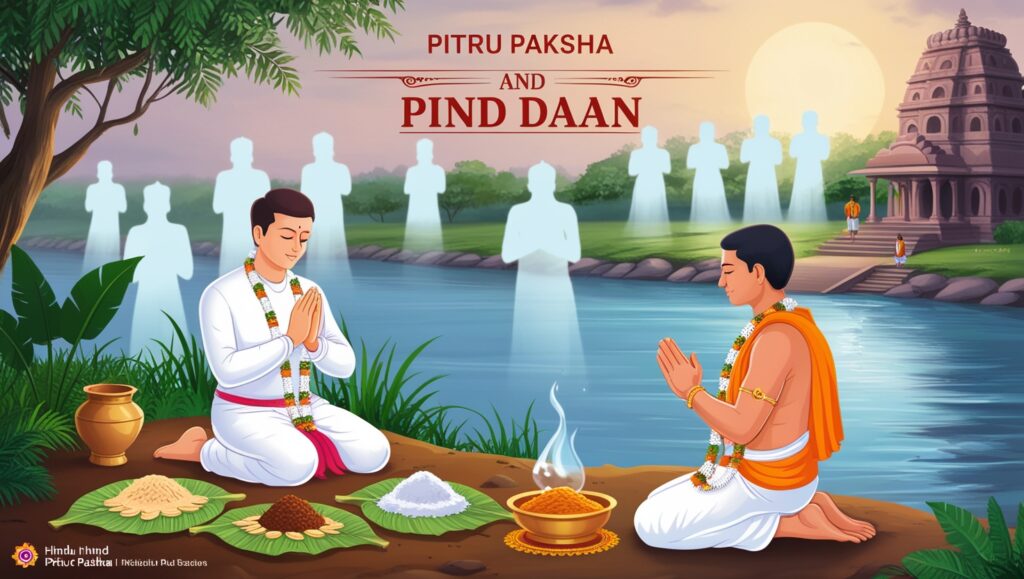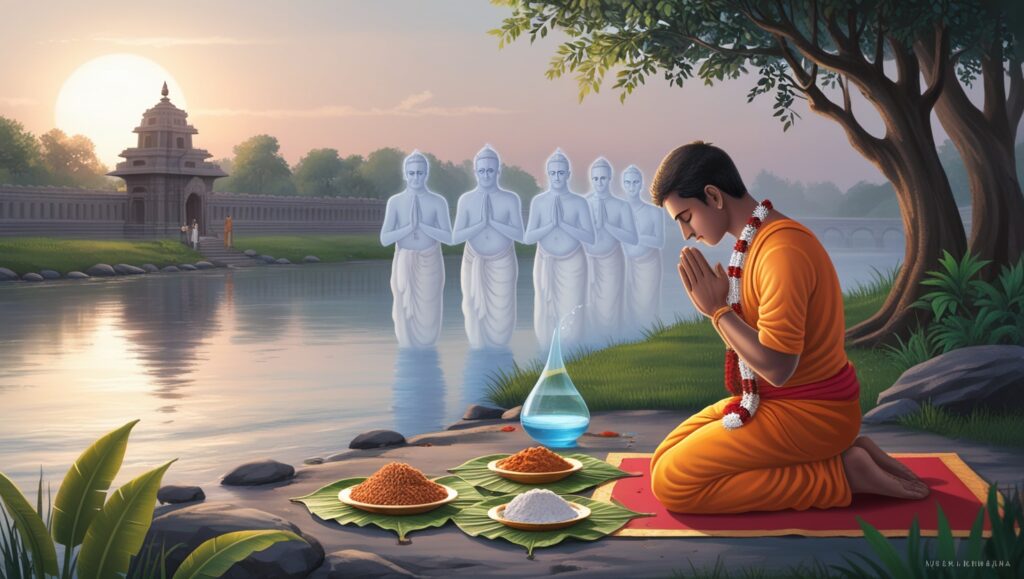In Hinduism, ancestral respect and reverence are fundamental aspects of spiritual practice, deeply embedded in the fabric of the culture. Two important rituals that embody this reverence are Pitru Paksha and Pind Daan, both aimed at ensuring peace and liberation for departed souls. These rituals not only uphold the connection between the living and their ancestors but also serve as an expression of gratitude and responsibility toward forebears.
To listen to a more detailed Podcast of this blog, watch the YouTube Video below:
What is Pitru Paksha?
Pitru Paksha (or Pitri Paksha) is a 16-day period dedicated to honoring one’s ancestors. This annual observance takes place during the waning phase of the lunar month of Bhadrapada (September-October), immediately preceding the Navratri festival.
1. Purpose of Pitru Paksha
Pitru Paksha is a time when Hindus remember their departed ancestors and offer them Shraddha (food and prayers). According to belief, during this period, the souls of ancestors visit the Earth to receive offerings from their descendants, who in turn seek blessings for prosperity, health, and well-being.
2. Shraddha Rituals in Pitru Paksha
Shraddha is the core ritual performed during Pitru Paksha. Families offer food, water, and prayers to satisfy their departed ancestors. The offerings typically include rice, black sesame seeds, and ghee, and are placed on banana leaves or in holy water bodies. The rituals are usually conducted by the eldest male member of the family, although other family members may also participate.

3. Importance of Performing Shraddha
Performing Shraddha during Pitru Paksha is believed to please the ancestors, ensuring peace for their souls and blessings for the family. If these rites are neglected, it is thought that the ancestors may be displeased, causing misfortune or hardships to the family.
4. Mahalaya Amavasya
The final day of Pitru Paksha, known as Mahalaya Amavasya or Sarvapitru Amavasya, is the most important day for performing Shraddha. On this day, Hindus offer special prayers and food for all ancestors, even for those whose death anniversary is unknown or unrecorded.
5. The Mythological Significance
The story of Karna from the Mahabharata highlights the significance of Pitru Paksha. After his death, Karna was denied food in heaven because, while alive, he had only donated wealth but not food. To rectify this, he was sent back to Earth for 16 days to offer food to his ancestors, marking the origin of Pitru Paksha as a period for such offerings.
Understanding Pind Daan: A Sacred Ritual of Ancestral Salvation
Pind Daan is another vital ancestral ritual in Hinduism, often performed in conjunction with Shraddha. It is the act of offering pindas (balls of food made from rice, wheat flour, sesame seeds, and ghee) to help the soul of a deceased person attain salvation, or moksha.
1. Purpose of Pind Daan
The main objective of Pind Daan is to aid the soul of the deceased in attaining peace and freedom from the cycle of rebirth. Hindus believe that a soul without the proper post-death rites may remain in a state of limbo, causing distress for both the soul and the family. By performing Pind Daan, the family ensures the soul’s smooth transition to the afterlife.
2. How is Pind Daan Performed?
Pind Daan typically involves the preparation of pindas, which symbolize the physical body of the deceased. These pindas are offered to the soul, accompanied by prayers for its peace. The ritual can be performed on specific occasions like death anniversaries, as part of the last rites, or during pilgrimage to holy sites.

3. Importance of Holy Sites for Pind Daan
Though Pind Daan can be performed at any sacred location or even at home, certain pilgrimage sites, like Gaya in Bihar, hold special significance for this ritual. Gaya is believed to be the place where Lord Vishnu himself accepts these offerings for the ancestors, granting them eternal peace.
4. When is Pind Daan Performed?
While Pind Daan can be done at any time, it is particularly significant during the Pitru Paksha period or on the death anniversary (tithi) of the deceased. It is often performed by the eldest son or a male member of the family, though, in modern practice, women and other family members can also participate.
Pitru Paksha vs. Pind Daan: Key Differences
Although both Pitru Paksha and Pind Daan are performed to honor ancestors, they differ in terms of focus, purpose, and timing.
| Aspect | Pitru Paksha | Pind Daan |
|---|---|---|
| Focus | Honors all ancestors collectively | Focuses on the salvation of a specific soul |
| Occasion | Observed annually during a 16-day period | Performed after death, on death anniversaries, or during pilgrimage |
| Ritual | Shraddha (food and water offerings) | Offering pindas (food balls) to the deceased |
| Purpose | To seek blessings and honor the ancestors | To ensure the soul’s liberation and peace |
| Location | Performed at home, temples, or sacred sites | Often performed at holy places like Gaya |
| Main Performer | Usually the eldest male, but can vary | Usually the eldest son or male heir |
The Spiritual and Cultural Impact
Both Pitru Paksha and Pind Daan hold profound spiritual and cultural significance in Hinduism. They serve as reminders of the cyclical nature of life and death and reinforce the bond between the living and the deceased. Performing these rites is seen as fulfilling a duty (dharma) to one’s ancestors, ensuring the continuity of familial harmony and spiritual well-being.
Conclusion: The Eternal Connection
The Hindu practices of Pitru Paksha and Pind Daan exemplify the deep respect for ancestors in Indian culture, reflecting the belief that death is not an end, but a transition. By honoring the departed souls, Hindus maintain a sacred connection with their forebears, ensuring that their blessings guide and protect the living family members. Through these rituals, they seek to bring peace not only to the departed but also to themselves, knowing that their ancestors rest in harmony.

